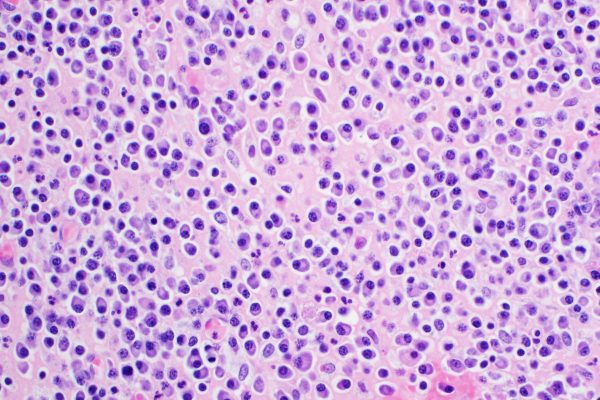
For patients with transplant-eligible newly-diagnosed multiple myeloma (NDMM), treatment with lenalidomide, bortezomib and dexamethasone (RVd), followed by autologous stem cell transplantation (ASCT) represents the standard of care in first-line. Unfortunately, multiple myeloma remains an incurable disease in the vast majority of patients and novel treatment regimens with manageable toxicity are needed to improve the depth of response, overall survival (OS) and progression-free survival (PFS).
In multiple myeloma, the achievement of a stringent complete response (sCR) after ASCT was found to be associated with improvements in OS and PFS and minimal residual disease (MRD) testing was reported to be a sensitive measure of depth of response, strongly correlating with OS and PFS. Therefore, the randomised, open-label phase II GRIFFIN study was designed to assess whether the addition of daratumumab to RVd (D-RVd) and ASCT could improve the depth of response, including sCR and MRD negativity, in patients with NDMM. Daratumumab is a human immunoglobin G kappa monoclonal antibody that targets CD38 and has recently proven its worth in the CASSIOPEIA study where it was added to triplet induction and consolidation therapy with bortezomib, thalidomide and dexamethasone in patients with transplant-eligible NDMM.
In the GRIFFIN study, NDMM patients (N = 207) were randomised (1:1) to D-RVd or RVd induction (4 cycles) followed by ASCT, D-RVd or RVd consolidation (2 cycles), and lenalidomide or lenalidomide plus D maintenance (26 cycles). Primary endpoint of the trial was the sCR rate at the end of post-ASCT consolidation.
The primary endpoint of sCR by the end of post-ASCT consolidation was achieved in significantly more patients in the D-RVd group as compared to the RVd group (42.4% vs. 32.0%, odds ratio: 1.57, 95%CI: 0.87-2.82, 1-sided p= 0.68). In addition, responses deepened over time and after a follow-up of 22.1 months, the percentage of patients with sCR reached 62.6% in the D-RVd group and 45.4% in the RVd group (odds ratio: 1.98, 95%CI: 1.12-3.49, p= 0.0177).
Also the MRD negativity (10-5) rate was higher for patients in the D-RVd arm as compared to patients in the RVd arm for the intent-to-treat population (51.0% vs. 20.4%, p< 0.0001) and amongst patients who achieved a complete response or better (62.0% vs. 32.2%, p= 0.0006). No clinically significant impact on stem cell mobilisation or engraftment was reported. The addition of daratumumab to RVd did not lead to unexpected safety concerns and adverse events were consistent with observations from the safety run-in.
The addition of daratumumab to RVd (D-RVd) resulted in significantly improved rates of sCR and MRD negativity with an acceptable safety profile. These results indicate that the D-RVd regimen might become the new standard of care for patients with transplant-eligible NDMM.
Reference
Voorhees PM, Kaufman JL, Laubach J, et al. Daratumumab, lenalidomide, bortezomib, and dexamethasone for transplant-eligible newly diagnosed multiple myeloma: the GRIFFIN trial. Blood. 2020;136(8):936-45.